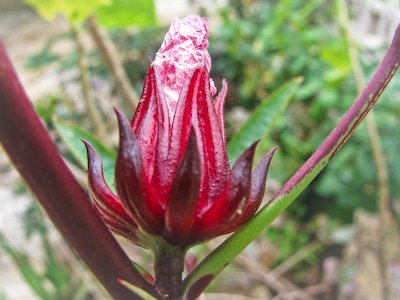Over the holidays I discovered that I have borderline high blood pressure, due in part to genetics (Gee, thanks Dad!). Although I already eat a relatively healthy diet and exercise regularly, I’ve been researching what other changes I need to make to reverse the trend in my blood pressure before it becomes a more serious problem. Incorporating more herbs into my diet is definitely recommended.
Being a gardener, I don’t just want to buy the herbs, I want to grow them myself and have some fun learning how to use them. Over the last couple of months I have been reading up on herbs from different parts of the world used both for hypertension and for general heart maintenance. Now before I go any further, I need to say that I am not a doctor, or even a trained herbalist. I am not giving medical advice. Only some of these herbs have been evaluated in double blind studies, and of those, the variety or species that I can grow in Texas is not necessarily the same one that has been studied. That said, this is the list that I am going to try to grow this year.
Hibiscus sabdariffa: Hibiscus tea, called Jamaica (ha mai ca) in Mexico and sorrel in the Carribean. A study published in Phytomedicine showed that a daily 16 oz glass of hibiscus tea could lower diastolic blood pressure by ten points. I now drink this tasty tea almost daily. Luckily for me in Austin, a lot of restaurants serve it here as well. Last year I grew one plant and harvested enough flowers to make a few batches of tea. It is not actually the flower that is used to make the tea, but the red calyces. This year I will be growing several plants. Seeds are available from Baker Creek Heirloom Seeds.
Agastache mexicana: Known as Lemon Hyssop, Mexican Hyssop and Toronjil. It is related to the more commonly grown Anise Hyssop Agastache foeniculum. It is used traditionally in parts of Mexico, but I am not aware of any studies that confirm or negate its effectiveness. Seeds are available from The Thyme Garden in Oregon.
Crataegus reverchonii or Crataegus texana: Reverchon Hawthorn and Texas Hawthorn. There are over 200 species of hawthorns. Rosemary Gladstar, in her Family Herbal book, recommends C. oxyacantha and C. monogyna as a general heart tonic. The German Comission E Study recommends C. orycantholdes. The berries of this shrubby tree are made into tea or jam. The two species that I listed grow in Central Texas and I’m going to fit one of them into my backyard. Again, I’m not aware of studies using the species that I will be growing.
Allium sativa and Allium cepa: Garlic and onions. Don’t overlook these great plants just because they are not rare and unknown. Multiple studies have shown garlic, particularly raw garlic, to have a moderate blood pressure lowering effect.
Lycium barberum: Wolf Berry or Goji Berry. I had a chance to chat with David Creech of the Stephen F. Austin Arboretum in Nacogdoches last weekend and he told me that the berries of this small shrub in the tomato family are added to teas in China for hypertension. Seeds from The Thyme Garden.
Taraxacum officinale: Yes, the lowly dandelion. I have a feeling that I will get more than a few of these volunteering in my garden this year. Going to use my CobraHead to harvest the roots and use them in tea. The tea has a diuretic effect.
In addition to using the herbs, I’m making an effort to use relaxation techniques such as meditation as well as monitoring my blood pressure daily to notice changes, positive or negative. Gardening relaxes me most of the time, so the effects of growing the herbs hit me even before I ingest them.


Hawthorne is recommended by Dr. Peter D’Adamo in his 4YourType nutrition book.
We have 2 CobraHeads. My wife especially likes the long handled one. Anyway, I am a member of Maine Organic Farmers and Gardener’s Association. Every year in September, they hold The Common Ground Fair. This fair has grown into one of the biggest fairs on the east coast. I was thinking that since you people like to attend different functions on the North American continent, you might want to check it out. Possibly drum up some more business for the CobraHead line of tools.
Just sharing some thoughts. Happy gardening!
PS We love the tools & the news letter.
Leslie,
Thanks for the note. We have been wanting to participate in the Common Ground fair for a while and also visit Maine. Its just a matter of making the logistics work out.
Geoff